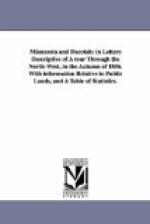[1 I take pleasure in inserting here a note which I have had the honor to receive from Captain Pope, of the Corps of Topographical Engineers I have before had occasion to quote from the able and instructive report of his exploration of Minnesota.
Washington, D. C. Dec. 10, 1856.
Dear sir:— Your note of the 6th instant is before me; and I will premise my reply by saying that the suggestions I shall offer to your inquiries are based upon my knowledge of the condition of the territory in 1849, which circumstances beyond my acquaintance may have materially modified since.
The important points to be secured for the new state to be erected in the territory of Minnesota, seem to be:— first a harbor on Lake Superior, easily accessible from the West; second, the whole course of the Mississippi to the Iowa line; and, third, the head of navigation of the Red River of the North. It is unnecessary to point out the advantages of securing these features to the new state; and to do so without enclosing too many square miles of territory, I would suggest the following boundaries, viz.:
Commencing on the 49th parallel of latitude, where it is intersected by the Red River of the North, to follow the line of deepest water of that river to the mouth of the Bois des Sioux (or Sioux Wood) River; thence up the middle of that stream to the south-west point of Lake Traverse; thence following a due south line to the northern boundary of the state of Iowa (43 degrees 30’ north latitude); thence along this boundary line to the Mississippi River; thence up the middle of the Mississippi River to the mouth of the St. Croix River; thence along the western boundary line of the state of Wisconsin to its intersection with the St. Louis River; thence down the middle of that river to Lake Superior; thence following the coast of the lake to its intersection with the boundary line between the United States and the British possessions, and following this boundary to the place of beginning.
These boundaries will enclose an area of about 65,000 square miles of the best agricultural and manufacturing region in the territory, and will form a state of unrivalled advantages. That portion of the territory set aside by the boundary line will be of little value for many years to come. It presents features differing but little from the region of prairie and table land west of the frontier of Missouri and Arkansas. From this, of course, are to be excepted the western half of the valley of the Red River and of the Big Sioux River, which are as productive as any portion of the territory, which, with the region enclosed between them, would contain arable land sufficient for another state of smaller dimensions.
As you will find stated and fully explained in my report of February, 1850, the valley of the Red River of the North must find an outlet for its productions towards the south, either through the great lakes or by the Mississippi River. The necessity, therefore, of connecting the head of its navigation with a harbor on Lake Superior, and a port on the Mississippi, is sufficiently apparent. As each of these lines of railroad will run through the most fertile and desirable portion of the territory, they will have a value far beyond the mere object of transporting the products of the Red River valley.




